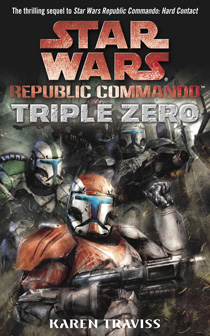Karen Traviss’ “Republic Commando” series started off with a pulpy war mission novel, “Hard Contact,” which also snuck in the notion of clones as thinking, feeling human beings – something that most prior novels and the people of the fictional GFFA ignored. In “Triple Zero” (2006), Traviss ratchets up her game by bringing the action to Coruscant (the galactic coordinates of which are “000”), enriching the clones’ backstory and building up future threads.
For crying out loud, there’s an eight-page glossary of Mandalorian terms in the back. Not just in her storytelling, but also in her world-building, Traviss did more to invent clone and Mando culture than George Lucas ever would, and I can understand why she took it as a personal insult when he reinvented the planet Mandalore in Season 2 of “The Clone Wars.”
A reader can sense Traviss’ confidence growing throughout “Triple Zero.” Her writing method is deceptively simple: A lot of the prose is about the clones’ mission to take out a Separatist terrorist cell on Coruscant, and it gets into details of the strategy, equipment and logistics that you’d expect from a former defense correspondent — right down to the fact that one of the operatives, the Wookiee Enacca, regularly has to fetch the team’s abandoned vehicles. But she writes an equal amount is about the characters’ feelings, personalities, backstories, thoughts and relationships. This often comes through exchanges of dialogue, as if her fictional charges serve as de facto psychiatrists for one another.
Whereas the “X-Wing” series – my second-favorite “Star Wars” series behind this one – would alternate action scenes with the pilots’ reflections in an enjoyable way, the “Republic Commando” series mashes action and feelings together. Traviss isn’t shy about backing off from the plot for a moment to let you know what the soldiers are thinking, not just about the mission but about the big picture of their lives. It’s an unorthodox but effective approach.
I am staunchly anti-war, yet I find myself sympathizing with and even rooting for these clones who were bred to kill, yet who don’t for one moment think about what they are fighting for (other than to accomplish the mission, to stay alive, and to keep their brothers alive). Additionally, they don’t spend much time thinking about the wrongness of the fact that they were created to be slaves for the Republic war effort. They are aware of this truth – “I know I’m being used, thanks,” Fi tells the Coruscant Security Force’s Jaller Obrim on page 376 – but, owing to the narrow worldview burned into them, it doesn’t occur to them to try to escape it (at least not yet). What keeps Fi going are “my brothers. And that ale you promised me.”
Every character in “Triple Zero” has a starkly dual nature. The clones – who are 20-something in physical development but around 10 in real years — are hardened warriors yet sweet, innocent lads (they prefer juice to ale, and are utterly awkward around females). So despite the fact that they are stone-cold killers, I feel toward them as I do toward the 6-year-olds in “Ender’s Game” – they are too young, and too deeply manipulated, to bear the brunt of the blame for the evils of war.

By the way, Traviss doesn’t use the easy dodge of having her clones fight droids, as they mostly do in the movies and TV series, and mostly did in “Hard Contact”; here, the enemies are flesh and blood. And some of the targets loosely connected to the Separatist terror cell just barely qualify as bad guys; at least, one could argue that death is not a proportional punishment for their crime. So the fact that she still has me liking this brutal bunch is quite an achievement.
The clones’ trainer and father figure, Kal Skirata (mentioned in the last book, but now practically the main character), lives his life solely to see to his sons’ safety and well-being, yet he’s a vicious mercenary killer. Another of the trainers, Walon Vau, believed so much in hardening his charges that he nearly killed one of them – Atin – in training, yet he loves his pet Mird to the point where he’ll sleep on the landing platform with him.
Etain and Jusik don’t outright reject their Jedi heritage, but they are both absorbed by Skirata’s family – which is understandable, because the stark Jedi culture doesn’t provide the warmth that this makeshift family does. Jusik always wants to prove his worth to Skirata and his boys, while Etain continues her relationship with Darman, which started in “Hard Contact.” Here, she becomes pregnant with his son. In her “a-ha” moment on page 306, Etain realizes that the lives of Jedi (taken from their parents to become warriors) and clones (parentless; created to be warriors) are very similar.
“Triple Zero” has many more characters than “Hard Contact.” The first book gave us Omega Squad – Niner, Darman, Fi and Atin. Here, we also get Delta Squad – Boss, Scorch, Fixer and Sev — plus two of Skirata’s Null captains – Ordo and Mereel. The Nulls are from an early batch that the Kamino cloners were going to destroy because they were emotionally unstable, but Skirata saved them and raised them. The group also absorbs the stray Republic data analyst Corr, whom Ordo impersonates as part of the mission.
“Triple Zero” plays like a soap opera, in a good way. As Darman, Atin and Ordo find relationships (Atin with Twi’lek waitress Laseema, Ordo with the beautiful Grand Army of the Republic logistics chief Besany Wennen), Fi feels jealous. While he sets aside his personal grudge during the mission, Atin aims to kill Vau as revenge for nearly killing him during training, and he’s not joking about it. And in a side thread that’s barely referenced here but which will be picked up later in the five-book “Commando” series and then in “Legacy of the Force,” Mereel works to track down the missing Kamino cloner Ko Sai. It’s part of Skirata’s long game to provide a real life for his sons after the war.
“Triple Zero’s” sense of place is pretty decent, particularly at the group’s makeshift headquarters, a hotel/restaurant owned by a Hutt who owes Skirata. While the bustling walkways of Coruscant bring forth the clones’ thoughts about what a non-soldiering life might be like, Traviss drops the ball slightly on the geography of the planet. There is one scene where Fi and Sev cross a makeshift bridge over a steep drop, but I didn’t get the sense of the city-planet’s verticality as much as in some other novels.
Admittedly, I’m reaching for something to complain about there. Overall, “Triple Zero” – despite barely acknowledging movie characters (Etain mentions once that Obi-Wan is a rare Jedi general who wears trooper armor) — announces the “Commando” series as a serious part of “Star Wars” lore, one in which all future installments will be must-reads.

